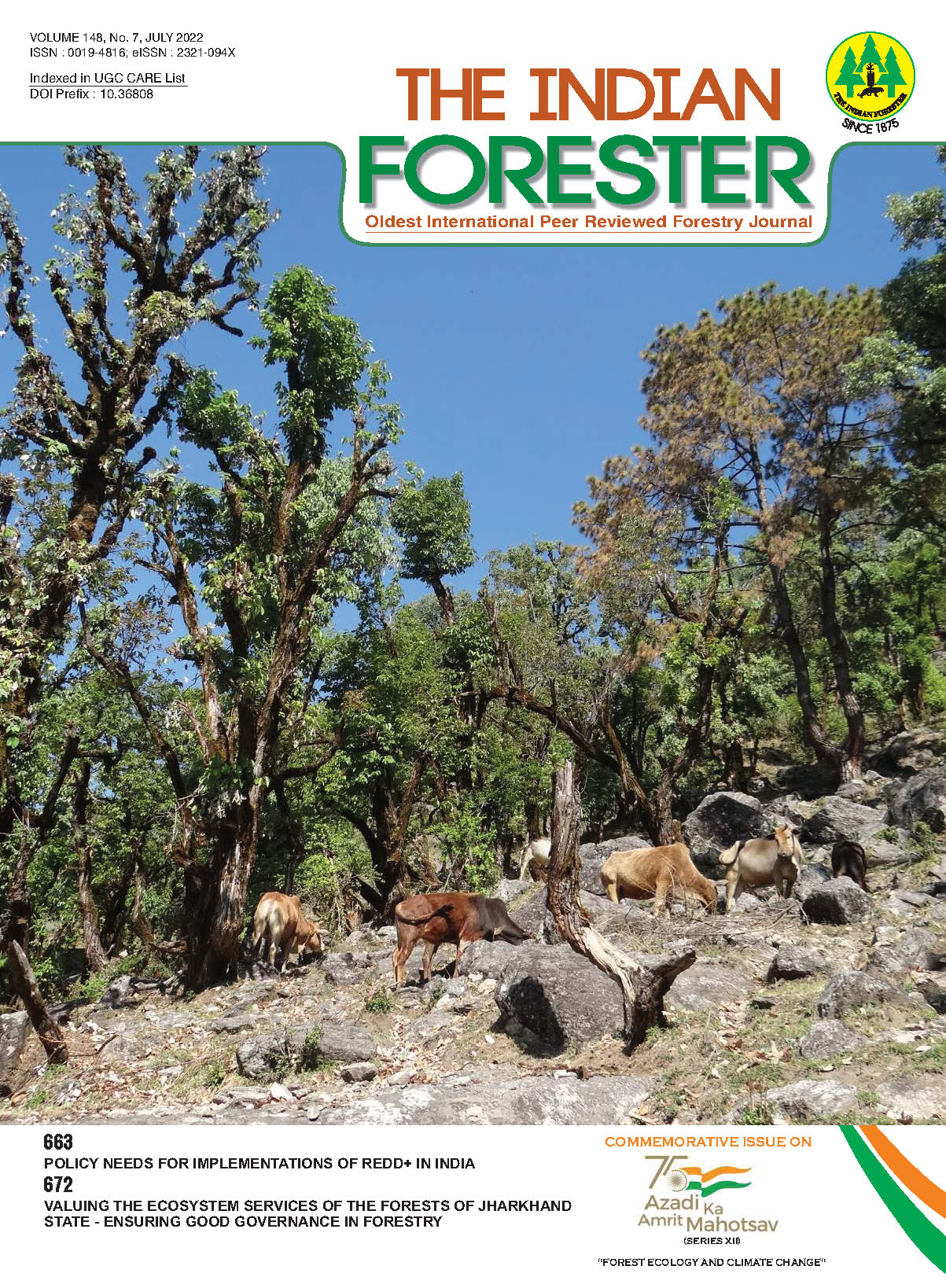Host Density Influence on Regularly Fallen Lichen Species in Temperate Forests of Kumaun Himalaya
DOI:
https://doi.org/10.36808/if/2022/v148i7/151902Keywords:
Regularly fallen lichen species, biomass, density, hosts, temperate forestAbstract
Lichens are very slow growing plants and play a significant role in forest ecosystem. In temperate areas lichens occur abundant on Quercus trees. After falling down lichens decompose into the soil and contribute in nutrient cycling. In the present study nine regularly fallen lichen species were recorded in three altitudinal zones. The density of fallen lichen was found maximum 95625 ind. ha-1 yr-1 at lower altitude followed by 70125 at higher altitude. The lichen biomass ranged between 5375 g ha-1 yr-1 to 7862.5 g ha-1 yr-1 in all the studied sites. Across the study sites seasonal highest biomass (11687 g ha-1) of fallen lichens was estimated in summer followed by 3198 in winter and 2950 during rainy season. Minimum biomass was recorded in spring season of about 2262 g ha-1. Similarly, annual highest biomass of fallen lichens was recorded 7862.5 g ha-1 at lower altitude. Quercus leucotrichophora, Pinus roxburghii and Rhododendron. arboreum trees were observed as luxuriant lichens particularly in lower altitude. Parmotrema praesorediosum contributes a maximum 85.37% biomass of all species at lower altitude. At higher altitude R. conduplicans contributes maximum 31.13% followed by P. tinctorum (27.70%) and E. cirrhatum (19.31%) of the total fallen lichen biomass.References
Arya M.K., Kumar B., Arya V. and Sonam (2017). Lichen litter decomposition impact on soil nutrients of Kumaun Himalaya, India. International Journal Advance Research and Development, 2(6): 476-479.
Arya M.K., Kumar B., Arya V. and Sonam (2017). Seasonal variation in lichen litter in different forest types of Kumaun Himalaya, India. International Journal of Botany Studies, 2(4): 28-31.
Awasthi D.D. (1988). Key to macrolichen of India and Nepal. Journal Hattori Botany Laboratory, 65: 207-307.
Awasthi D.D. (2000). Lichenology in Indian subcontinent. A supplement to a Hand Book of Lichens. Shiva Offset Press Dehradun India.
Boucher V.L. and Nash T.H. III (1990). The role of the fruticose lichen Ramalinamenziesii in the annual turnover of biomass and macronutrients in a Blue Oak woodland. Botany Gazette, 151: 114-118.
Boudreault C., Bergeron Y., Coxson D.S. (2009). Factors controlling epiphytic lichen biomass during postfire succession in black spruce boreal forests. Can. J. For. Res. 39: 2168–2179.
Curtis J.T. and McIntosh R.P. (1956). An upland forest continuum in prairie forest border region of Wisconsin. Ecology, 32:76-96.
Degelius G (1978). Further studies on the epiphytic vegetation of twigs. Acta. Universitatis Gothoburgensis Botanik 7: 1-58.
Du Rietz G.E. (1945). Om fattigbark- ochRikbarksamhallen. SvenksBotaniskTidsskrift 39:147-50.
Dudgeon W. (1923). Succession of epiphytes in the Quercus incanaforest at Landour, Western Himalayas. Journal of Indian Botanical Society 3:159-272.
Esseen P.A., Renhorn K.E. and Pettersson R.B. (1996). Epiphytic lichen biomass in managed and old growth forests: effect of branch quality. Ecol. Appl. 6:228-238.
Hawksworth D.L. and Honegger R. (1994). The lichen thallus: a symbiotic phenotype on nutritionally specialized fungi and its response to gall producers. In: Williams MAJ (ed) Plant galls: organisms, interactions, populations. Clarendon Press, Oxford 77-78.
Knops J.M.H., Nash T.H. III, Boucher V.L. and Schlesinger W.H. (1996). The influence of epiphytic lichens on the nutrient cycling of an oak woodland. Ecol. Monogr, 66: 159-179.
Kumar B. (2010). Ecological, Social and commercial role of lichens in India with special reference to Garhwal Himalayas. Academia Arena Supplement, 201:1-106.
Kumar B. (2009). Lichens resource use pattern and its socioeconomic status in temperate region of Garhwal Himalaya, India. Nature and Science, 7(2):101-106.
Kumar B. (2012). Exploitation and depletion of lichens in high altitude regions district Chamoli, Garhwal Himalaya. In ecology and culture of Uttarakhand Eds by BL Sah. Maa Durga Prakashan Haldwani 78-83.
Kumar B. and Upreti D.K. (2008). An account of lichens on fallen twigs of three Quercus species in Chopta forest of Garhwal Himalayas, India. Annals of Forestry, 15(1): 92-98.
Kumar B., Upreti D.K., Singh S.P. and Tewari A. (2009). Seasonal pattern of lichen fall from trees in an evergreen Quercus semecarpifolia forest of Garhwal Himalaya, India. Nature and Science, 7(3): 8-12.
Mc Cune B. and Greiser L. (1997). Macrolichens of Pacific Northwest. Oregon State University Press, Corvallis U.S.A.
Mishra R. (1968). Ecology Work Book. Calcutta, New Delhi: Oxford and IBH Publishing Company.
Pike L.H. (1978). The importance of epiphytic lichens in mineral cycling. Bryologist, 81(2): 247-257.
Rhoades F.M. (1995). Nonvascular epiphytes in forest canopies: worldwide distribution, abundance and ecological roles. In forest canopies; Eds Lowman MD Nadkarni NM Academic Press: Cambridge CA, USA 353-408.
Sonam, Kumar B., Arya V. and Upreti D.K. (2017). Lichens as key indicators of forest health in Sauni-Binsar grove, Kumaun Himalaya, India. Indian Journal of Ecology, 44(3): 654-657.
Stone D.F. (1989). Epiphytic succession on Quercus garryana branches in Willamette valley of western Oregon. Bryologist, 92: 81-94.
Upreti D.K. and Chaterjee S. (1999a). Distribution of lichens on Quercus and Pinus trees in Almora district Kumaun Himalayas, India. Geophytology, 28(1&2): 41-49.
Upreti D.K. and Chaterjee (1999b). Epiphytic of lichens on Quercus and Pinus trees in the three forest stands in Pithoragarh district Kumaun Himalayas, India. Tropical Ecology, 40(1): 41-49.
Downloads
Downloads
Published
How to Cite
Issue
Section
License
Unless otherwise stated, copyright or similar rights in all materials presented on the site, including graphical images, are owned by Indian Forester.





